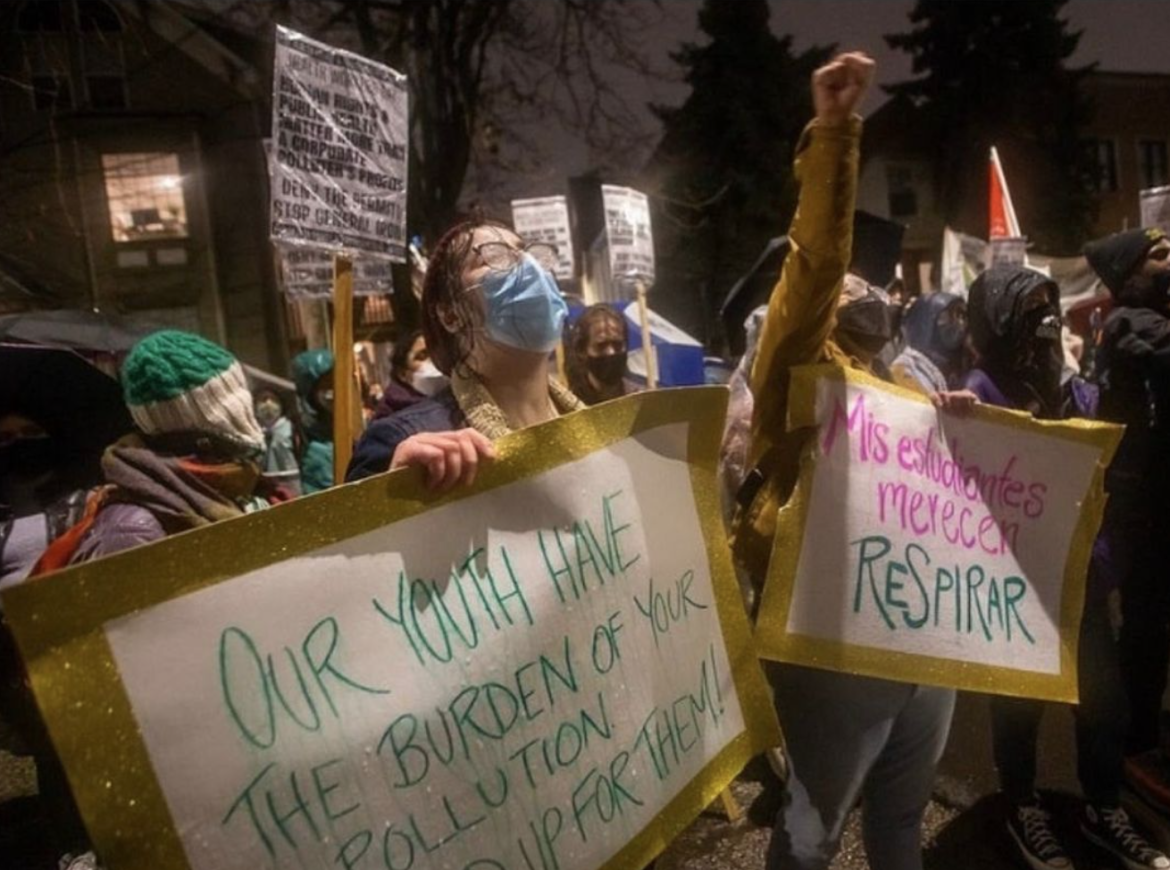
This article was republished here with permission from Great Lakes Echo.
By Wajeeha Kamal, Great Lakes Echo
Chicago is joining a nationwide trend of large cities incorporating equity or justice goals into preparing for climate change’s impact on public health.
The idea is to better protect Black, Hispanic, Indigenous and other socially vulnerable and marginalized communities. That hasn’t always been the case.
“There’s a bunch of different versions of this sort-of truism in public health and one version of that goes ‘your zip code matters more than your genetic code when it comes to your health,’” said Sean Vallas, director of Michigan State University’s Center for Bioethics and Justice.
Chicago was a city that did not articulate justice as a core feature of climate change, according to a 2022 Boston University study. That has changed in the past year in the wake of a federal civil rights complaint filed by Southeast Environmental Task Force, the South East Side Coalition to Ban Petcoke and People for Community Recovery.
Brandon Johnson, elected mayor last April, has vowed to end what he calls “literal sacrifice zones.” He characterized such zones as Black and Latino neighborhoods “where industrial firms are allowed to pollute the air, water and soil with impunity, making residents sick and degrading their quality of life,” according to WTTW News.
Environmental injustice is when “contamination disproportionately burdens neighborhoods where residents are predominantly low-income and/or racial or ethnic minorities,” according to a 2023 Loyola University study.
Addressing it must go beyond increasing access to green spaces and cleaning up contamination, the study said. That’s because Black, Hispanic, Indigenous and other vulnerable social groups are disproportionately harmed by economic inequality, structural racism, limited enforcement of environmental and public health regulations, and land use decisions.
Health is deeply impacted by how people live their everyday lives, Vallas said. That includes whether you live in overcrowded housing, if you’re afraid to walk to work or if you have a difficult commute.
“And what kind of air are you breathing along the way?” Vallas said. “When you pass grocery stores, are they selling mostly cigarettes and convenience foods? Or do you have actual options for fruits and vegetables that you can afford?
“These are the things that matter to people’s lives.”
How Chicago plans to confront environmental injustice
The civil rights complaint alleged the city discriminated by helping relocate an iron scrapyard from Lincoln Park, a majority white neighborhood, to a Southeast Side majority Black and Hispanic neighborhood. It said that constraining polluting land uses to majority Black and Hispanic areas and relocating them from predominantly white areas is discriminatory.
In 2022, Chicago began working on a Cumulative Impact Assessment that supported the requirements of the city’s 2021 voluntary compliance agreement with the U.S. Department of Housing and Urban Development. It took 15 months to complete and includes an Environmental Justice Action Plan.
The purpose of the assessment was to provide data on how environmental burdens and other stressors vary in impact across the city. That same year, the city denied General Iron’s permit application to relocate from Lincoln Park to the Southeast Side because of the health risk it posed for residents.

Southeast Environmental Task Force in the fight for justice against General Iron. Image: Southeast Environmental Task Force’s Instagram
The city now focuses on developing housing that is affordable and accessible to low and moderate-income Chicagoans in high-amenity parts of the city, said Matt Stern, senior project manager of the 2022 Chicago Climate Action Plan and the Environmental Justice Action Plan. Simultaneously, the city is also investing in revitalizing historically marginalized communities.
Stern said the city is drafting new zoning ordinances and changes in both departmental and city policy. One reform made zoning changes that impacted the density of housing and the density of parking. It could have substantial impacts on the cost of housing near mass transit, Stern said.
“We think about the kinds of projects that we fund and the geographies that we funded them in,” he said. “We also have a number of programs that build and repair homes for low and moderate-income families.”
This includes a brand new single-family decarbonization program, home repair programs and other things to support existing low and moderate-income homeowners, he said” The decarbonization program upgrades homes with new insulation and heating and cooling systems to reduce reliance on fossil fuels that contribute to climate changes.
Robert Weinstock, director of the Environmental Advocacy Center at Northwestern Pritzker School of Law, represented the Southeast Environmental Taskforce in the civil rights case and is now working to ensure the city’s newly developed Environmental Justice Action plan is equitable.
The roots of the problem run deep.
Families moved to Southeast Side neighborhoods to work in steel mills and auto plants, Weinstock said. Many of those plants shut down in the 70s and 80s, but the families remain. The GI Bill required public housing agencies to find new places for returning World War II veterans, Weinstock said. White people resisted Black returning soldiers living in those neighborhoods.
Federal policy required the people living in newly developed public housing units to “reflect” the same composition as current residents, Weinstock said. “There are various laws and policies and social forces that have left us with one of the most highly racially segregated cities in the country.”
An example is Altgeld Gardens Homes, west of an industrial area formerly home to the Pullman train car factory, steel and auto plants. Moreover, in the case of the civil rights complaint, low-income Black and Hispanic populations would be forced to move-out of areas around the industrial corridor along the north branch of the Chicago River because of intense, high-end real estate pressure.
Large-scale projects that focus on real estate or tourism development tend to contribute to gentrification, according to the Loyola study. Real estate development involves attracting residents with environmental improvements, such as access to transit, jobs, health care providers, schools and grocery stores. That attracts wealthier and often white residents.
“People wanted to build fancy condos there and fancy homes,” Weinstein said.
“And so, the remaining industrial properties that were in that industrial corridor, were moving out,” Weinstein said. And the city was intentionally trying to move them out.
“To make way for this development, in 2015 and 2016, the city started working with the owners of General Iron, to facilitate a move from what they called ‘this gentrifying industrial corridor’ to what they referred to as ‘receding corridors.’”
The challenge of environmental justice
Remediating the damage from polluting facilities goes far beyond just removing a polluter or cleaning up the local environment, according to the Loyola study.
Even if polluters are removed, the land is cleaned up and a park is constructed, the challenge is that all of those things make the neighborhood much more desirable for other people, said Phil Warsaw, a community sustainability professor at Michigan State University.
That surge in demand leads to increased housing prices.“That makes it unaffordable for the community that’s already living there… so that’s where you run into the issue of gentrification,” Warsaw said.
To avoid such “green gentrification,” Stern said the city supports mixed-use projects for areas in need of revitalizing.
“What that means for us is looking for encouraging ground floor retail and whether it’s a partnership with grocery stores or other particular amenities that communities need, and look to support that wherever we can,” he said.
Catch more news at Great Lakes Now:
Photobook illuminates the beauty of Michigan lighthouses
Smart buoys help brace Great Lakes for environmental challenges
Featured image: A member of the Southeast Environmental Task Force protests sacrifice zones, Black and Hispanic communities that are targeted for polluting industries. Image: Southeast Environmental Task Force’s Instagram.




